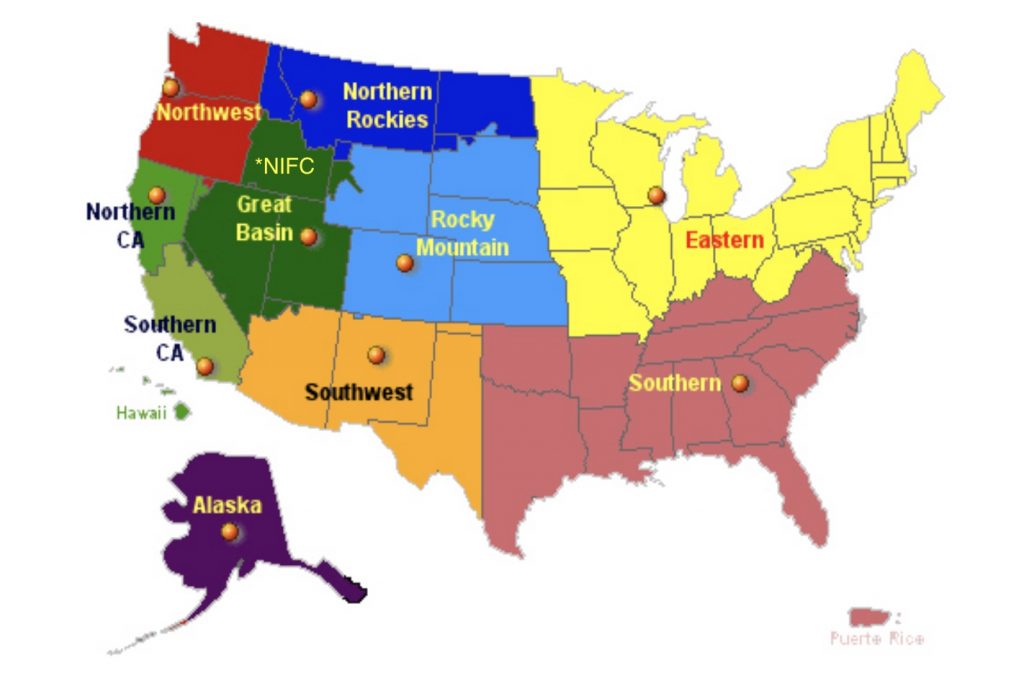
by Ellen Gray / BOISE, IDAHO/
The FIREX-AQ campaign is flying out of Boise, Idaho. The choice of location was no accident. Boise is also home to the National Interagency Fire Center (NIFC), the nerve center of all major firefighting operations for the United States. Earlier this week, we took a tour.
“NIFC is not an organization, it’s a place. Each big bureau dealing with fires has people here,” said Kari Cobb, our tour guide with the Bureau of Land Management in the Department of Interior that hosts the center.
In addition to the Bureau of Land Management, the agencies working together to put out major wildfires, support the crews in the field and assist with other disasters include the National Association of State Foresters, the USDA Forest Service, the Department of Defense, the National Oceanic and Atmospheric Administration, the Bureau of Indian Affairs, the National Park Service, the United States Fire Administration, and the U.S. Fish and Wildlife Service.
The center is located next to the Boise Airport – across from the Idaho Air National Guard where the DC-8 is stationed for FIREX-AQ. Airport access is essential for the helicopters and planes used to deliver crews and supplies to firefighting teams in the field, and also for reconnaissance planes that survey active fires with infrared instruments to detect hotspots hidden by smoke plumes.
The Radio Cache

In order to coordinate, you need to be able to communicate. NIFC’s Radio Cache ensures that’s possible. They manage, repair and refurbish the 11,000 handheld radios and radio repeaters that get delivered to firefighters in the field. They deliver the equipment in kits that are already pre-programmed to be ready to plug-and-play as soon as they arrive. While all the radios are ultimately managed and dispatched from Boise, they pre-position equipment closer to likely fire activity and other disaster-prone areas.
The Great Basin Cache

When you’ve got people fighting fires for weeks on end, you need a place for them to sleep, eat and manage day-to-day operations. Kari described the giant warehouse that makes up the Great Basin Cache as the “Costco” of wildland fire management. It’s the largest of the 16 caches set up in different parts of the country, and has everything needed for the Incident Command Posts, from tents, sleeping bags, tables, and coffee, to firefighters’ personal protective gear, and the shovels, Pulaskis (axe plus flat-head scraper), MCleods (a type of rake) and combi-tools (with a shovel and pick head) they use to clear vegetation and dig fire breaks.
Smokejumpers

There are plenty of people willing to jump out of perfectly good airplanes, but not nearly as many willing to jump out of a plane next to a wildfire. In the United States, there are 450 in fact, and 80 to 85 of these smokejumpers are stationed out of Boise at any given time. Currently most of the Boise smokejumpers are at out-stations, located across the West to be closer to fire-prone areas.
They’re delivered to remote fires by Twin Otter aircraft and jump from 3000 feet in special gear made of Kevlar that each smokejumper has made themselves (they’re required to know how to sew and use a sewing machine.) They jump with one main parachute, a reserve parachute and two days of personal gear. Once they’re on the ground, the plane drops supply kits for two firefighters for two days. Their regular firefighting gear is on under their jump suit, which they stash before getting to work. Once they’ve done their initial assessment and work at the fire site, relaying info back to base, they hike out.
National Weather Service Boise

Weather conditions – wind, humidity, rain and temperature – are fundamental to understanding what a fire is doing and where it will go next. The National Weather Service station in Boise monitors and forecasts weather for southwest Idaho and western Oregon. They’re staffed 24 hours a day, and use satellite imagery and models to forecast not only the weather, but fire weather – conditions favorable for burning. They also track lightning strikes, which are one of the main causes of wildfires in the region.
National Interagency Coordination Center

Putting it all together is the National Interagency Coordination Center – effectively a national dispatch center, which manages the support resources and sends them into the field where they are needed. Fire management begins locally, at the town or county level. When their capacity for fighting a wildfire is exceeded, they go to their regional support center, one of eleven spread throughout the country. When their resources are exceeded, that’s when they call on the National Interagency Coordination Center in Boise – who then pulls crews from other regions, and sometimes Canada, Australia and New Zealand, to help put out the fires. They also supply information, helicopters and water tankers, and handle getting food and showers in place at the Incident Command Post.
Join us on @NASAExpeditions Twitter and NASA Expeditions Facebook for more from FIREX-AQ.
